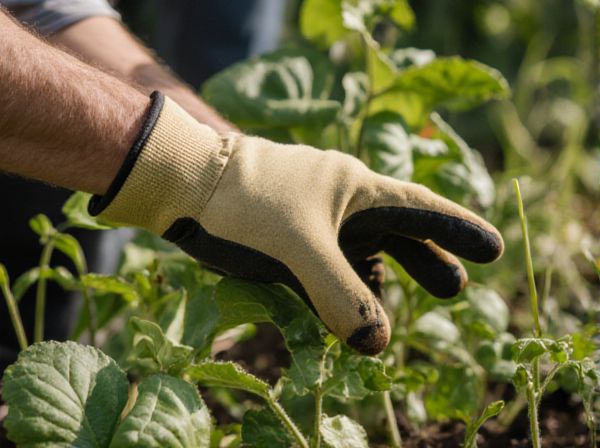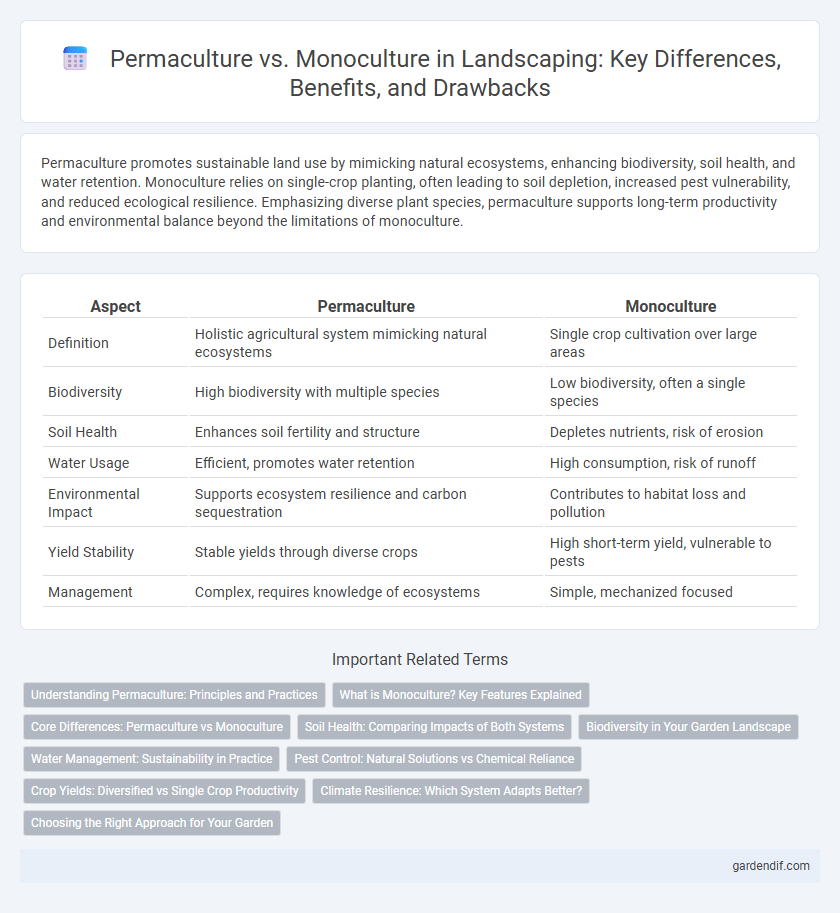
permaculture vs monoculture Illustration
Permaculture promotes sustainable land use by mimicking natural ecosystems, enhancing biodiversity, soil health, and water retention. Monoculture relies on single-crop planting, often leading to soil depletion, increased pest vulnerability, and reduced ecological resilience. Emphasizing diverse plant species, permaculture supports long-term productivity and environmental balance beyond the limitations of monoculture.
Table of Comparison
| Aspect | Permaculture | Monoculture |
|---|---|---|
| Definition | Holistic agricultural system mimicking natural ecosystems | Single crop cultivation over large areas |
| Biodiversity | High biodiversity with multiple species | Low biodiversity, often a single species |
| Soil Health | Enhances soil fertility and structure | Depletes nutrients, risk of erosion |
| Water Usage | Efficient, promotes water retention | High consumption, risk of runoff |
| Environmental Impact | Supports ecosystem resilience and carbon sequestration | Contributes to habitat loss and pollution |
| Yield Stability | Stable yields through diverse crops | High short-term yield, vulnerable to pests |
| Management | Complex, requires knowledge of ecosystems | Simple, mechanized focused |
Understanding Permaculture: Principles and Practices
Permaculture integrates sustainable agricultural principles that mimic natural ecosystems by emphasizing biodiversity, soil health, and water conservation, contrasting sharply with monoculture's focus on single-crop production and intensive resource use. Core permaculture practices include companion planting, crop rotation, and the creation of resilient ecosystems that promote long-term productivity and ecological balance. Understanding permaculture principles like care for the earth, care for people, and fair share helps landscape designers foster sustainable, regenerative environments that reduce environmental impact and enhance biodiversity.
What is Monoculture? Key Features Explained
Monoculture is an agricultural practice that involves growing a single crop species over a large area, which often leads to decreased biodiversity and increased vulnerability to pests and diseases. Key features of monoculture include uniform planting, high dependency on chemical fertilizers and pesticides, and intensive use of machinery, all aimed at maximizing short-term yield. This approach contrasts sharply with permaculture, which emphasizes diverse, sustainable ecosystems that work in harmony to enhance soil health and resilience.
Core Differences: Permaculture vs Monoculture
Permaculture emphasizes biodiversity, soil health, and sustainable ecosystems by mimicking natural processes, whereas monoculture relies on single-crop planting that often depletes soil nutrients and increases vulnerability to pests. Permaculture integrates various plant species, animals, and organic matter to create resilient landscapes with minimal external inputs. In contrast, monoculture prioritizes high yields through uniform crop production, frequently necessitating chemical fertilizers and pesticides.
Soil Health: Comparing Impacts of Both Systems
Permaculture enhances soil health by promoting biodiversity, improving organic matter, and supporting natural nutrient cycles, which leads to increased soil fertility and structure. Monoculture depletes soil nutrients rapidly, reduces microbial diversity, and often requires synthetic fertilizers, resulting in soil degradation and erosion. Sustainable landscape management favors permaculture practices to restore and maintain long-term soil vitality.
Biodiversity in Your Garden Landscape
Permaculture promotes biodiversity by integrating diverse plant species that support natural ecosystems, enhancing soil health and pest control. In contrast, monoculture landscapes focus on a single crop species, which often reduces habitat variety and increases vulnerability to pests and diseases. Incorporating permaculture principles in your garden landscape encourages resilient ecosystems and sustainable resource use.
Water Management: Sustainability in Practice
Permaculture integrates diverse plant species and natural water retention techniques, enhancing soil moisture and reducing runoff for sustainable water management. Monoculture often leads to soil degradation and increased water consumption due to uniform crop requirements and lack of biodiversity. Employing permaculture principles fosters resilience by promoting efficient water use and minimizing the need for irrigation in landscape design.
Pest Control: Natural Solutions vs Chemical Reliance
Permaculture employs natural pest control methods such as companion planting, beneficial insects, and biodiversity to create a balanced ecosystem that minimizes pest outbreaks. Monoculture relies heavily on chemical pesticides, which can lead to pest resistance, soil degradation, and harm to non-target organisms. Emphasizing ecological pest management, permaculture promotes sustainable agriculture by enhancing soil health and reducing dependency on synthetic chemicals.
Crop Yields: Diversified vs Single Crop Productivity
Permaculture systems enhance crop yields by promoting biodiversity, which improves soil health, pest resistance, and resource efficiency, resulting in more stable and sustainable productivity over time. Monoculture practices focus on maximizing yield of a single crop but often lead to soil degradation, pest outbreaks, and nutrient depletion, which can reduce long-term productivity. Diverse crop polycultures in permaculture typically produce higher aggregate yields per unit area compared to monocultures, benefiting both ecosystem resilience and food security.
Climate Resilience: Which System Adapts Better?
Permaculture creates diverse ecosystems by integrating multiple plant species, which enhances soil health, improves water retention, and increases resilience to climate extremes. Monoculture relies on single crops, making systems more vulnerable to pests, diseases, and variable weather patterns due to reduced biodiversity. Climate adaptation favors permaculture for its capacity to maintain stability and productivity under changing environmental conditions.
Choosing the Right Approach for Your Garden
Permaculture emphasizes biodiversity, soil health, and sustainable resource use, creating resilient ecosystems that mimic natural patterns. Monoculture focuses on single-crop cultivation, which can simplify management but often depletes soil nutrients and increases vulnerability to pests. Selecting the right approach depends on garden size, goals, and long-term sustainability, with permaculture recommended for ecological balance and monoculture suited for high-yield, short-term production.
permaculture vs monoculture Infographic

 gardendif.com
gardendif.com